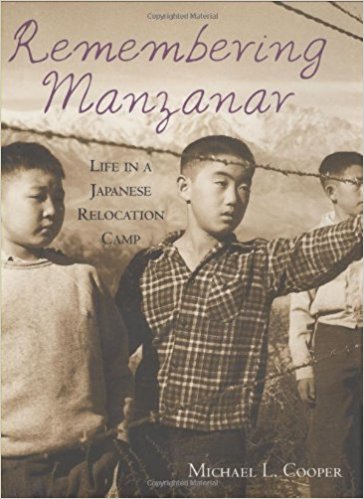Remembering Manzanar: Life in a Japanese Relocation Camp (book)
Creators: Michael Cooper
Book for younger children about the Manzanar concentration camp.
Synopsis
Remembering Manzanar begins and ends with the author Michael L. Cooper's first-person description of attending the 2001 Manzanar Pilgrimage . After discussing the continuing impact the incarceration has had on Japanese Americans and their continuing interest in the story in chapter one, Cooper asks, "why is it important for other Americans to remember Manzanar?" Chapter two focuses on Terminal Island in telling the story of the exclusion and forced removal of Japanese Americans. Chapters three and four cover living conditions and life at Manzanar, with a focus on aspects such as education and recreational activities that would be of interest to young readers. He also covers the Manzanar riot/uprising and the loyalty questionnaire episode. The final chapter goes back to the pilgrimage and ends with a mention of bigotry those of Middle Eastern descent faced after the 9/11 attacks and the need to remember the story of Manzanar.
The book includes many large photographs as well as profiles of three of the key photographers, Dorothea Lange , Ansel Adams , and Toyo Miyatake .
Additional Information
Author Michael L. Cooper (1950– ) was born in Kentucky and raised in a small town there. He later moved to New York to become a writer. Since 1988, he has written over fifteen books for young adults, most on aspects of American history, and many on the experiences of African Americans and other ethnic minority groups. His 2004 book Dust to Eat: Drought and Depression in the 1930s won the 2005 Golden Kite Award for best nonfiction book from the Society of Children's Book Writers and Illustrators. In addition to Remembering Manzanar , Cooper also authored Fighting for Honor (2000) for Clarion Books.
The book is historically accurate for the most part, and according to the author, was based mostly on primary research, in particular issues of the Manzanar Free Press —excerpts of which appear throughout the text—and the community analysis reports of Morris Opler along with interviews with former inmates Sue Kunitomi Embrey and Wilbur Sato. The book contains only a few minor errors: the Japanese radish is spelled "dakon" instead of "daikon" (page 26); Cooper claims that after the Manzanar riot/uprising, both the "pro-Japanese" and "pro-American evacuees" were sent to a "special high-security prison camps in Arizona" (39); only the instigators were sent to the War Relocation Authority prison in Leupp, Arizona ; the "pro-American" inmates were removed for their own protection to the Cow Creek camp near Death Valley and most subsequently left the camps for resettlement in Midwest or East); and in writing about the agricultural program at Manzanar, a claim that "the Manzanar farm was the largest" found in any of the WRA camps (51; both acreage and production at Manzanar were dwarfed by that of Gila River . Manzanar's acreage was also less than Tule Lake , Heart Mountain , Amache , and Poston , though its production trailed only Gila River and Tule Lake).
Find in the Digital Library of Japanese American Incarceration
Remembering Manzanar: Life in a Japanese Relocation Camp
This item has been made freely available in the Digital Library of Japanese American Incarceration , a collaborative project with Internet Archive .
Might also like
Fred Korematsu Speaks Up
by Laura Atkins and Stan Yogi;
The Invisible Thread
by Yoshiko Uchida;
The Unquiet Nisei: An Oral History of the Life of Sue Kunitomi Embrey
by Diana Meyers Bahr
| Author | Michael Cooper |
|---|---|
| Pages | 68 |
| Publication Date | 2002 |
For More Information
author website: http://www.michaellcooper.com/newsletter.htm .
